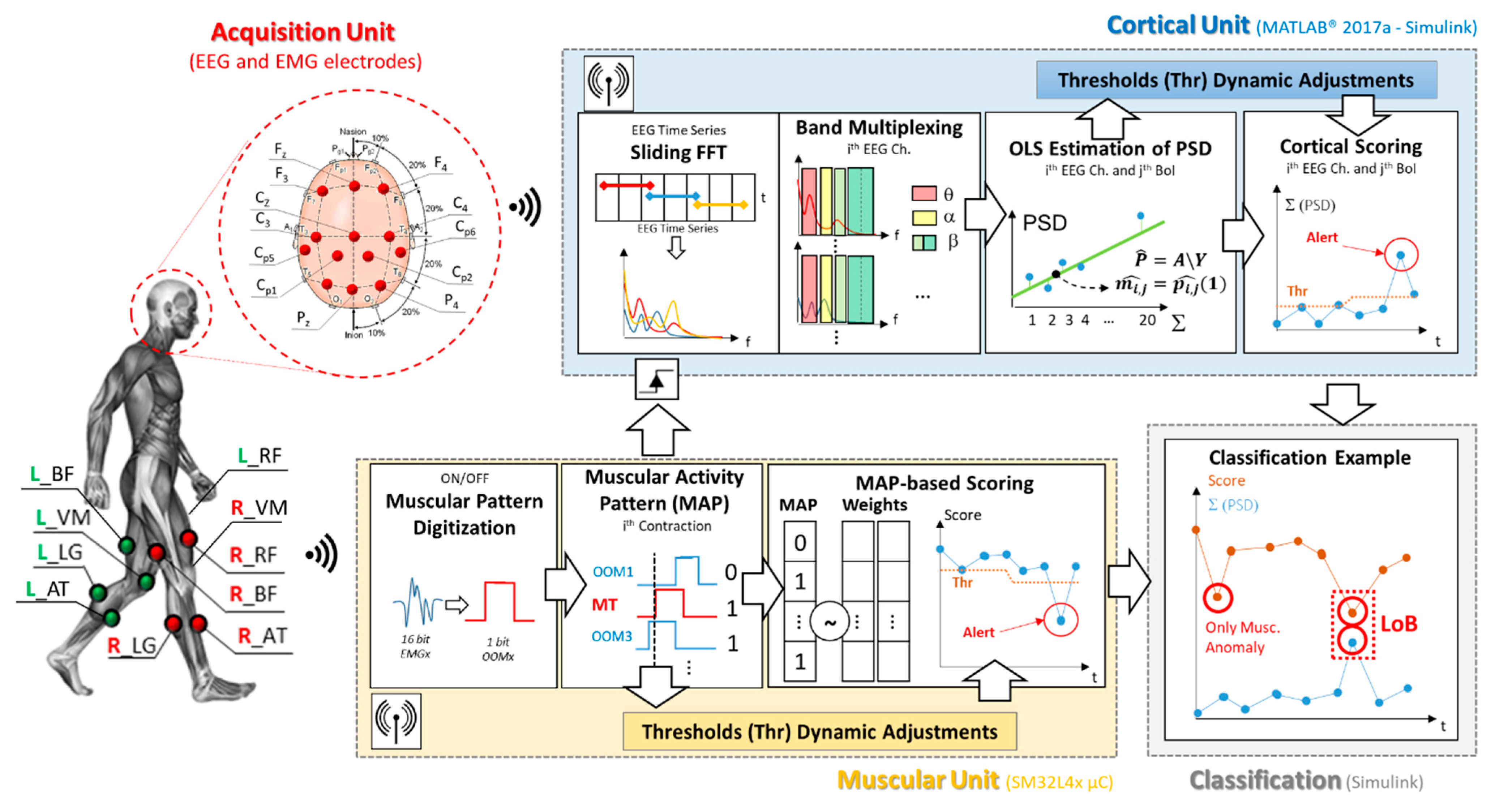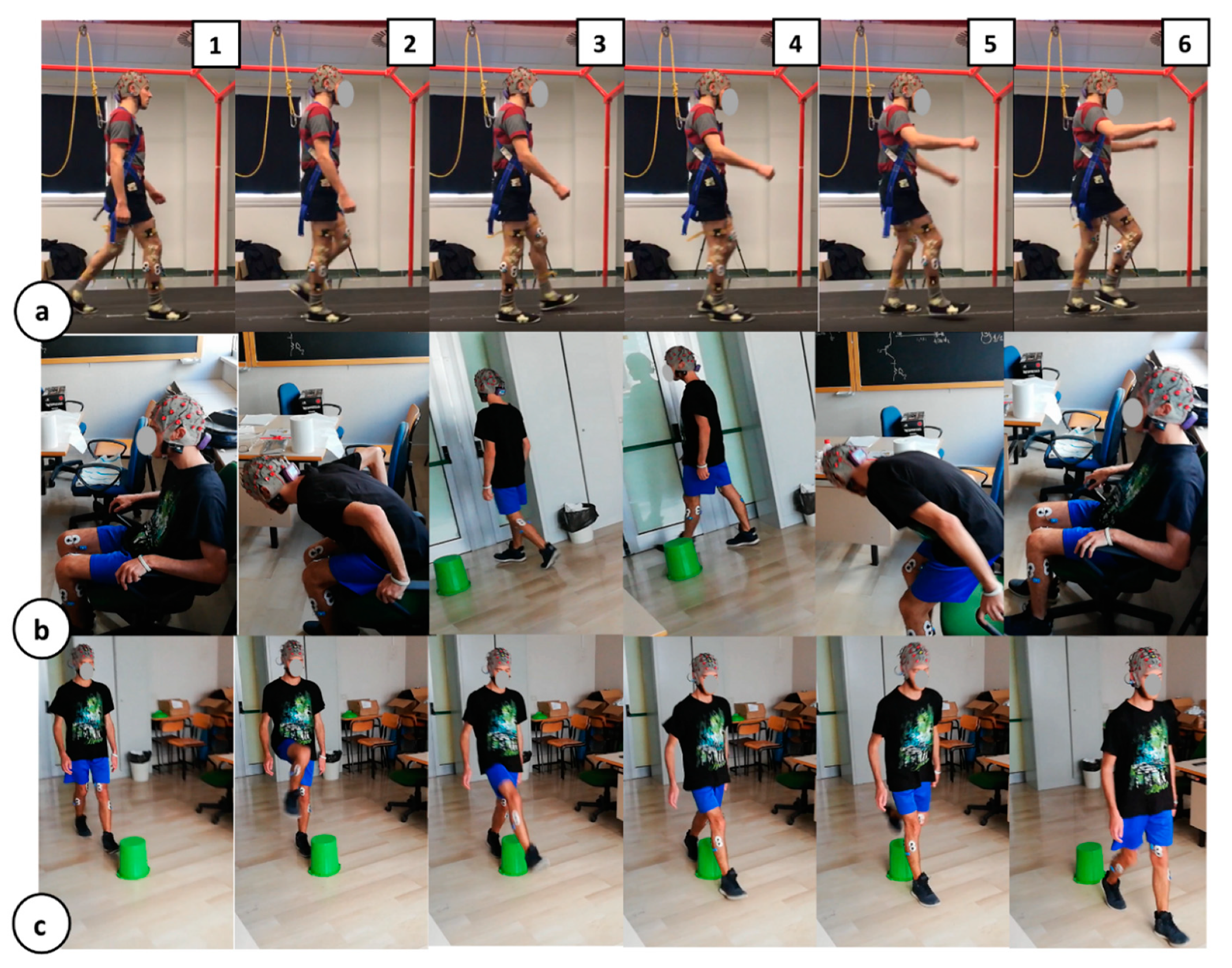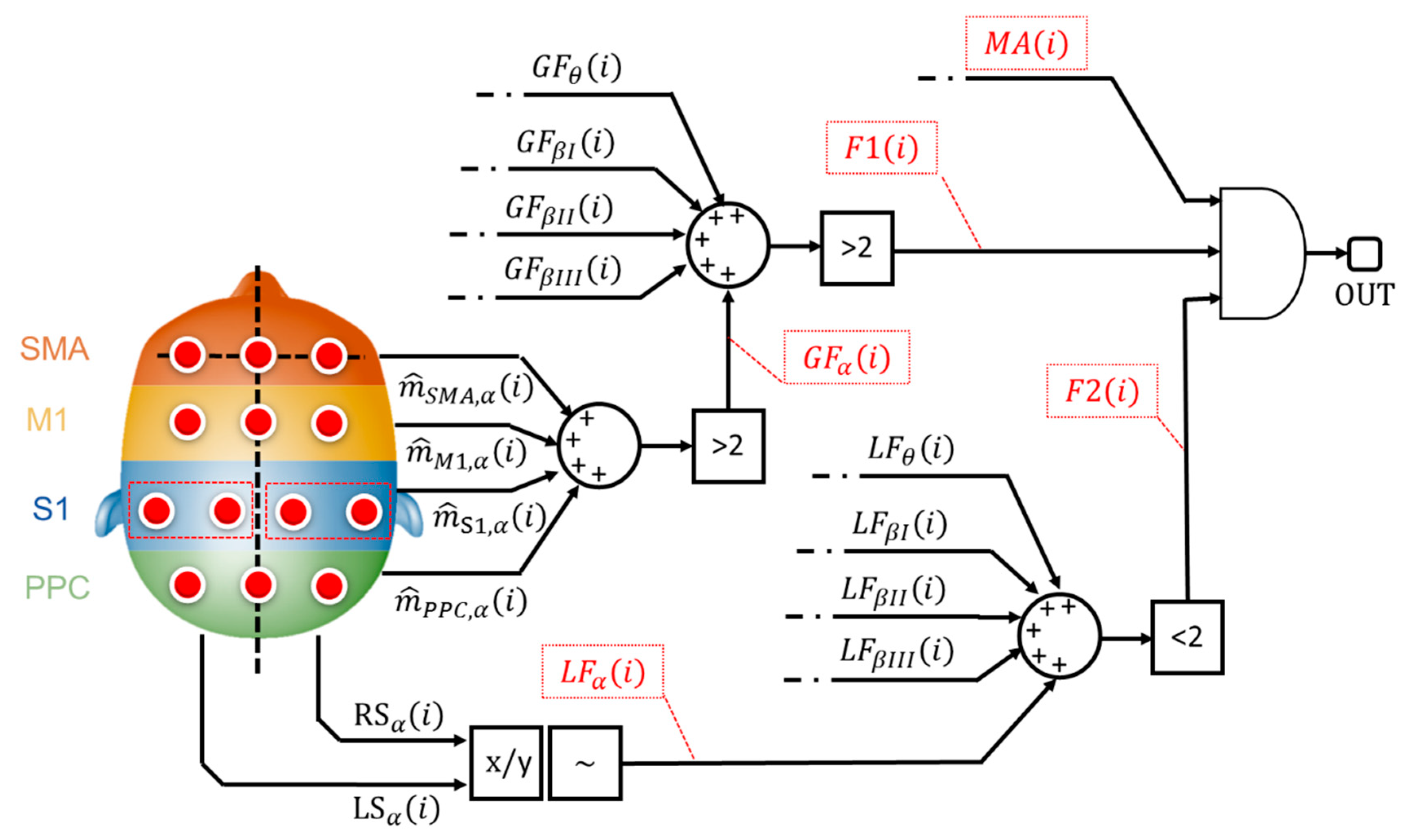High-Specificity Digital Architecture for Real-Time Recognition of Loss of Balance Inducing Fall
Abstract
1. Introduction
- Fall Indicators. The architecture exploits a novel joint analysis of bio signals: electromyography (EMG) and electroencephalography (EEG).
- High Sensitivity and Specificity. The algorithm robustness is tested both in presence of unexpected slippages (near-fall scenarios) and during four ADL-like tasks: (i) steady walking, (ii) sudden curves, (iii) chair transfers via timed up and go (TUG) test and (iv) balance-challenging obstacle avoidance.
- Quick Loss of Balance Recognition. The system detection time reached by the proposed architecture is conservatively below the maximum intervention time limit for the countermeasures implementation [17].
- Wearability. The proposed architecture is fully based on wireless and wearable sensors, ensuring—together with the high-specificity constraint—the suitability in ordinary life applications.
2. Materials and Methods
2.1. Participants
2.2. Architecture Overview
2.2.1. Acquisition Unit
2.2.2. Experimental Protocols
- Steady walking to near fall (slip). During this protocol, already presented in [26], the participants were asked to manage a slippage, unexpectedly provided during the steady walking by a mechatronic platform, called SENLY [32]. Specifically, the involved subjects underwent a series of 10 consecutive trials where their steady walking was unexpectedly perturbed by a slipping-like perturbation delivered in a pseudo-randomized order. Slippages consisted of a sudden and unexpected movement of one belt toward the antero-posterior (AP) direction. A demo of the protocols is shown in Figure 2a, panels (1) to (6).
- Steady walking with sudden curves. In this protocol, the participants were asked to manage a tight turn around a preset delimiter by keeping the walking speed as constant as possible. The panels (3) and (4) of Figure 2b provides an idea of the protocol described. To evaluate the system specificity against the ADL-like task response, only the contractions related to the sudden curves were collected.
- Chair transfer via timed up and go test. During the TUG test, the participants were asked to stand-up from a chair, walk toward a delimiter, carry out a tight turn around it and go back to the chair to sit- down again. The Figure 2b summarizes in 6 frames the TUG protocol. In this case, the contractions related to the sudden curves are kept in the sudden curves specificity database, while sit-down and stand-up contractions are collected in the dedicated TUG database.
- Balance-challenging obstacle avoidance. This protocol is shown via the 6-frame sequence in Figure 2c. In this protocol, the participants were asked to manage a sequence of obstacle avoidances, by alternating the support foot for every trial. Obstacle avoidance-related contractions have been collected in the dedicated database for the system specificity computation.
2.2.3. ON/OFF Muscular Pattern Extraction
2.2.4. Cortical Involvement Assessment
2.2.5. Muscular Activity Pattern Extraction
2.2.6. Muscular Activity Pattern (MAP)-Based Scoring Section
2.2.7. Cortical Scoring Section
- Supplementary motor area (SMA): F3, Fz, F4;
- Motor area (M1): C3, Cz, C4;
- Sensory-motor area (S1): Cp5, Cp1, Cp2, Cp6;
- Parietal area (PPC): P3, Pz, P4.
2.2.8. Logic Network-Based Classification
3. Results
3.1. Architecture Performance: Loss of Balance versus Steady Walking
3.2. Architecture Performance: System Robustness against Activities of Daily Life (ADL)
3.3. Acquisition Equipment Features
4. Discussion
5. Conclusions
Author Contributions
Funding
Acknowledgments
Conflicts of Interest
References
- Pelicioni, P.H.S.; Menant, J.C.; Latt, M.D.; Lord, S.R. Falls in Parkinson’s Disease Subtypes: Risk Factors, Locations and Circumstances. Int. J. Environ. Res. Public Health 2019, 16, 2216. [Google Scholar] [CrossRef] [PubMed]
- Bloem, B.R.; Hausdorff, J.M.; Visser, J.E.; Giladi, N. Falls and freezing of gait in Parkinson’s disease: A review of two interconnected, episodic phenomena. Mov. Disord. 2004, 19, 871–884. [Google Scholar] [CrossRef] [PubMed]
- Bloem, B.R.; Grimbergen, Y.A.M.; Cramer, M.; Willemsen, M.; Zwinderman, A.H. Prospective assessment of falls in Parkinson’s disease. J. Neurol. 2001, 248, 950–958. [Google Scholar] [CrossRef] [PubMed]
- Paul, S.S.; Sherrington, C.; Canning, C.G.; Fung, V.S.C.; Close, J.C.T.; Lord, S.R. The relative contribution of physical and cognitive fall risk factors in people with Parkinson’s disease: A large prospective cohort study. Neurorehabilit. Neural Repair 2014, 28, 282–290. [Google Scholar] [CrossRef] [PubMed]
- Allen, N.E.; Schwarzel, A.K.; Canning, C.G. Recurrent falls in Parkinson’s disease: A systematic review. Parkinsons Dis. 2013, 2013, 906274. [Google Scholar] [CrossRef] [PubMed]
- Stack, E.; Ashburn, A. Fall events described by people with Parkinson’s disease: implications for clinical interviewing and the research agenda. Physiother. Res. Int. 1999, 4, 190–200. [Google Scholar] [CrossRef]
- Ivan, P.; Okubo, Y.; Sturnieks, D.; Lord, S.R.; Brodie, M.A. Detection of near falls using wearable devices: A systematic review. J. Geriatr. Phys. Ther. 2019, 42, 48–56. [Google Scholar]
- Bianchi, F.; Redmond, S.J.; Narayanan, M.R.; Cerutti, S.; Lovell, N.H. Barometric pressure and triaxial accelerometry-based falls event detection. IEEE Trans. Neural Syst. Rehabil. Eng. 2010, 18, 619–627. [Google Scholar] [CrossRef]
- Casilari, E.; Luque, R.; Moron, M.J. Analysis of android device-based solutions for fall detection. Sensors 2015, 15, 17827–17894. [Google Scholar] [CrossRef]
- Srygley, J.M.; Herman, T.; Giladi, N.; Hausdorff, J.M. Self-report of missteps in older adults: A valid proxy of fall risk? Arch. Phys. Med. Rehabil. 2009, 90, 786–792. [Google Scholar] [CrossRef]
- Aziz, O.; Park, E.J.; Mori, G.; Robinovitch, S.N. Distinguishing near-falls from daily activities with wearable accelerometers and gyroscopes using Support Vector Machines. In Proceedings of the 2012 Annual International Conference of the IEEE Engineering in Medicine and Biology Society, San Diego, CA, USA, 28 August–1 September 2012; pp. 5837–5840. [Google Scholar] [CrossRef]
- Hu, X.; Qu, X. An individual-specific fall detection model based on the statistical process control chart. Saf. Sci. 2014, 64, 13–21. [Google Scholar] [CrossRef]
- Martelli, D.; Artoni, F.; Monaco, V.; Sabatini, A.M.; Micera, S. Pre-impact fall detection: Optimal sensor positioning based on a machine learning paradigm. PLoS ONE 2014, 9, e92037. [Google Scholar] [CrossRef] [PubMed][Green Version]
- Lee, J.K.; Robinovitch, S.N.; Park, E.J. Inertial sensing-based pre-impact detection of falls involving near-fall scenarios. IEEE Trans. Neural Syst. Rehabil. Eng. 2015, 23, 258–266. [Google Scholar] [CrossRef] [PubMed]
- Monaco, V.; Tropea, P.; Aprigliano, F.; Martelli, D.; Parri, A.; Cortese, M.; Molino-Lova, R.; Vitiello, N.; Micera, S. An ecologically controlled exoskeleton can improve balance recovery after slippage. Sci. Rep. 2017, 7, 46721. [Google Scholar] [CrossRef]
- Hu, X.; Qu, X. Pre-impact fall detection. Biomed. Eng. Online 2016, 15, 61. [Google Scholar] [CrossRef]
- Lajoie, Y.; Gallagher, S.P. Predicting falls within the elderly community: Comparison of postural sway reaction time the Berg balance scale and the activities-specific balance confidence (ABC) scale for comparing fallers and non-fallers. Arch. Gerontol. Geriatr. 2004, 38, 11–26. [Google Scholar] [CrossRef]
- Winter, D.A. Biomechanics and Motor Control of Human Movement; John Wiley & Sons: Hoboken, NJ, USA, 2009; p. 370. [Google Scholar]
- Varghese, J.P.; McIlroy, R.E.; Barnett-Cowan, M. Perturbation-evoked potentials: Significance and application in balance control research. Neurosci. Biobehav. Rev. 2017, 83, 267–280. [Google Scholar] [CrossRef]
- Cavanagh, J.F.; Frank, M.J. Frontal theta as a mechanism for cognitive control. Trends Cogn. Sci. 2014, 18, 414–421. [Google Scholar] [CrossRef]
- Klimesch, W.; Fellinger, R.; Freunberger, R. Alpha oscillations and early stages of visual encoding. Front Psychol. 2011, 2, 118. [Google Scholar] [CrossRef]
- Engel, A.K.; Fries, P. Beta-band oscillations—signalling the status quo? Curr. Opin. Neurobiol. 2010, 20, 156–165. [Google Scholar] [CrossRef]
- Neuper, C.; Pfurtscheller, G. Event-related dynamics of cortical rhythms: frequency-specific features and functional correlates. Int. J. Psychophysiol. 2011, 43, 41–58. [Google Scholar] [CrossRef]
- De Venuto, D.; Annese, V.F.; de Tommaso, M.; Vecchio, E.; Vincentelli, A.L.S. Combining EEG and EMG Signals in a Wireless System for Preventing Fall in Neurodegenerative Diseases. In Biosystems & Biorobotics; Andò, B., Siciliano, P., Marletta, V., Monteriù, A., Eds.; Springer: Cham, Switzerland, 2015. [Google Scholar]
- Berger, W.; Dietz, V.; Quintern, J. Corrective reactions to stumbling in man: Neuronal co-ordination of bilateral leg muscle activity during gait. J. Physiol. 1984, 357, 109–125. [Google Scholar] [CrossRef] [PubMed]
- Mezzina, G.; Aprigliano, F.; Micera, S.; Monaco, V.; De Venuto, D. EEG/EMG based Architecture for the Early Detection of Slip-induced Lack of Balance. In Proceedings of the 2019 IEEE 8th International Workshop on Advances in Sensors and Interfaces (IWASI), Otranto, Italy, 13–14 June 2019; pp. 9–14. [Google Scholar] [CrossRef]
- De Venuto, D.; Ohletz, M.J.; Ricco, B. Automatic repositioning technique for digital cell based window comparators and implementation within mixed-signal DfT schemes. In Proceedings of the Fourth International Symposium on Quality Electronic Design 2003, San Jose, CA, USA, 24–26 March 2003; pp. 431–437. [Google Scholar] [CrossRef]
- g.Nautilus Research Headset by g.Tec. Application note. Available online: http://www.gtec.at/Products/Hardware-andAccessories/g.Nautilus-Specs-Features (accessed on 31 October 2019).
- EMG Wave Plus by Cometa srl. Application Note. Available online: https://www.cometasystems.com/products/wave-plus-wireless-emg (accessed on 31 October 2019).
- De Venuto, D.; Tio Castro, D.; Ponomarev, Y.; Stikvoort, E. 0.8μW 12-bit SAR ADC sensors interface for RFID applications. Microelectron. J. 2010, 41, 746–751. [Google Scholar] [CrossRef]
- De Luca, C.J.; Gilmore, L.D.; Kuznetsov, M.; Roy, S.H. Filtering the surface EMG signal: Movement artifact and baseline noise contamination. J. Biomech. 2010, 43, 1573–1579. [Google Scholar] [CrossRef]
- Luciani, L.B.; Genovese, V.; Monaco, V.; Odetti, L.; Cattin, E.; Micera, S. Design and Evaluation of a new mechatronic platform for assessment and prevention of fall risks. J. Neuroeng. Rehabil. 2012, 9, 51. [Google Scholar] [CrossRef]
- De Venuto, D.; Ohletz, M.J.; Ricco, B. Testing of analogue circuits via (standard) digital gates. In Proceedings of the International Symposium on Quality Electronic Design, San Jose, CA, USA, 18–21 March 2002; pp. 112–119. [Google Scholar] [CrossRef]
- Blum, S.; Jacobsen, N.S.J.; Bleichner, M.G.; Debener, S. A Riemannian modification of Artifact Subspace Reconstruction for EEG artifact handling. Front. Human Neurosci. 2019, 13, 141. [Google Scholar] [CrossRef]
- De Venuto, D.; Ohletz, M.J.; Riccò, B. Digital Window Comparator DfT Scheme for Mixed-Signal ICs. J. Electron. Test. 2002, 18, 121. [Google Scholar] [CrossRef]
- Knight, J.F.; Deen-Williams, D.; Arvanitis, T.N.; Baber, C.; Sotiriou, S.; Anastopoulou, S.; Gargalakos, M. Assessing the Wearability of Wearable Computers. In Proceedings of the 2006 10th IEEE International Symposium on Wearable Computers, Montreux, Switzerland, 11–14 October 2006; pp. 75–82. [Google Scholar] [CrossRef]





| Reference | [11] | [12] | [13] | [14] | [15] | |
|---|---|---|---|---|---|---|
| Acquisition Devices 1 | n.7 IMU 6DoF sensor (GYR + ACC) | MCS: total body | MCS: total body | n.1 IMU 6DoF sensor (GYR + ACC) on waist (close CoG) | Hips Encoder on APO + MCS: validation on lower limbs | |
| Fall Indicators 2 | Means and variances of X, Y, Z for each ACC and GYR | Acceleration and VV of upper arms, trunk, tibia and head | Acceleration of all the monitored body segments | VV by integrating ACC data | ErF between Current Hips angle and predicted one | |
| Classification Approach 3 | ML: RBF kernel SVM | Multiple Thr + Statistics: threshold based on an ARIMA model | ML: (1) accelerations analysis by ICA (2) ANN | Single Thr: user-specific pre-impact VV threshold | Single Thr: increment of the ErF | |
| Recognized Classes 4 | ADL | Walking, Standing, correct chair transition, lying, picking up objects, ascending and descending stairs | Walking, Standing | Walking, Standing | Walking, Standing, correct chair transition, lying, picking up objects, ascending and descending stairs | Walking, Standing |
| Near Fall Scenarios | Slip, Trip, Incorrect chair transfer, misstep (recovery) | Slip (recovery) | Slip (recovery) | Slip, Trip, Incorrect chair transfer, misstep (recovery) | Slip (recovery) | |
| System Performance | Se (%) | 80–96 | 88.5 | 92.7 | 95.2 | 92.7 |
| Sp (%) | 90.8–99.2 | 92.9 | 98.0 | 97.6 | 98.0 | |
| DT (ms) | offline | Mean: 680.00 | Mean: 351.00 | Mean: 469.00 | Mean: 403.0 | |
| Applicability 5 | OL | ✘ | ✘ | ✘ | ✔ | ✘ |
| Clin. | ✔ | ✔ | ✔ | ✔ | ✔ | |
| FD | ✘ | ✘ | ✔ | ✔ | ✔ | |
| Subject | Se (%) | SpWS 1(%) | DT (ms) | |
|---|---|---|---|---|
| µ±σ | Max|Min | |||
| 1 | 90.00 (9/10) | 99.22 (386/389) | 369.83 ± 97.49 | 536.11 | 202.02 |
| 2 | 100.00 (10/10) | 98.32 (292/297) | 436.72 ± 86.66 | 634.21 | 371.15 |
| 3 | 90.00 (9/10) | 98.71 (308/312) | 299.76 ± 107.99 | 432.00 | 194.60 |
| 4 | 90.00 (9/10) | 98.55 (339/344) | 355.85 ± 151.38 | 581.35 | 198.73 |
| 5 | 90.00 (9/10) | 99.46 (370/372) | 446.72 ± 112.89 | 626.45 | 374.36 |
| 6 | 100.00 (10/10) | 99.20 (374/377) | 314.82 ± 105.34 | 501.23 | 160.42 |
| Avg 2 | 93.33 ± 5.16 | 98.91 ± 0.44 | 370.62 ± 60.85 | 634.21 |160.42 3 |
| Curves | Task 1 Sp. (%) | Task 2 Sp. (%) | Task 3 Sp. (%) | Subject Sp. (%) | ADL1 Sp. (%) |
| Sub. 1 | 96.55 (28/29) | 100.00 (23/23) | 100.00 (26/26) | 98.85 ± 1.99 | 99.62 ± 0.66 |
| Sub. 2 | 100.00 (34/34) | 100.00 (36/36) | 100.00 (35/35) | 100.00 | |
| Sub. 3 | 100.00 (51/51) | 100.00 (48/48) | 100.00 (49/49) | 100.00 | |
| TUG | Task 1 Sp. (%) | Task 2 Sp. (%) | Task 3 Sp. (%) | Subject Sp. (%) | ADL2 Sp. (%) |
| Sub. 1 | 97.50 (39/40) | 98.21 (55/56) | 96.88 (62/64) | 97.52 ± 0.67 | 98.95 ± 1.27 |
| Sub. 2 | 97.91 (47/48) | 100.00 (56/56) | 100.00 (48/48) | 99.30 ± 1.20 | |
| Sub. 3 | 100.00 (64/64) | 100.00 (64/64) | 100.00 (72/72) | 100.00 | |
| Obst. Avoidance | Task 1 Sp. (%) | Task 2 Sp. (%) | Task 3 Sp. (%) | Subject Sp. (%) | ADL3 Sp. (%) |
| Sub. 1 | 95.24 (40/42) | 98.61 (71/72) | 98.44 (63/64) | 97.48 ± 1.89 | 98.43 ± 0.88 |
| Sub. 2 | 100.00 (30/30) | 97.22 (35/36) | - | 98.61 ± 1.96 | |
| Sub. 3 | 100.00 (30/30) | 97.61 (41/42) | 100.00 (36/36) | 99.21 ± 1.37 |
| Reference | Recognized Classes | System Performance | Applicability | |||||
|---|---|---|---|---|---|---|---|---|
| ADL | Near Falls | Se (%) | Sp. (%) | DT (ms) | OL | Clin. | FD | |
| [11] | Walking, Standing, correct chair transition, lying, picking up objects, ascending and descending stairs | Slip, trip, incorrect chair transfer, misstep (recovery) | 80.0–96.0 | 90.8 – 99.2 | offline | ✘ | ✔ | ✘ |
| [12] | Walking, Standing | Slips (recovery) | 88.5 | 92.9 | 680.00 | ✘ | ✔ | ✘ |
| [13] | Walking, Standing | Slips (recovery) | 92.7 | 98.0 | 351.00 | ✔ | ✔ | ✔ |
| [14] | Walking, Standing, correct chair transition, lying, picking up objects, ascending and descending stairs | Slip, trip, incorrect chair transfer, misstep (recovery) | 95.2 | 97.6 | 469.00 | ✔ | ✔ | ✔ |
| [15] | Walking, Standing | Slip (recovery) | 97.6 | 98.0 | 403.00 | ✘ | ✔ | ✔ |
| This Work | Walking, Standing, Sudden curves, Chair transitions (TUG), Obstacle avoidance | Slips (recovery) | 93.3 | 98.9 1 | 370.62 | ✔ | ✔ | ✔ |
| Signal | Num. | Equipment Features | Electrode | Transmission Range | Resolution (Sampling FrEquation) | |
|---|---|---|---|---|---|---|
| Size (mm) | Type | |||||
| EEG | 13 channels | EEG Headset: Back Head Station: 70 × 55 × 30 mm Weight: 145 g Headset: Full-scalp elastic cap Weight: 12 g Wireless 10 h continuous acquisition @ 500Hz | 16 × 10 × 5 | Active Gel based Sintered Ag/AgCl probe | Modulo RF: XVV-MEGA22M00 (IEEE 802.15.4 WPAN @ 2.4GHz) Indoor Range: 17 m with 2.3–2.9dBm | 24 bit (@500 Hz) |
| EMG | 10 nodes | EMG Single Node: 33 × 23 × 19 mm Weight: 12 g Wireless 12 h continuous acquisition @ 2048 Hz | 18 × 12 × 5 | Active Pre-Gelled Sintered Ag/AgCl holder ring | Private protocol: Y9SMPTX 2.402–2.48 GHz Indoor Range: 15 m (+3dBm) | 16 bit (@2048 Hz ↓ 500 Hz) |
© 2020 by the authors. Licensee MDPI, Basel, Switzerland. This article is an open access article distributed under the terms and conditions of the Creative Commons Attribution (CC BY) license (http://creativecommons.org/licenses/by/4.0/).
Share and Cite
De Venuto, D.; Mezzina, G. High-Specificity Digital Architecture for Real-Time Recognition of Loss of Balance Inducing Fall. Sensors 2020, 20, 769. https://doi.org/10.3390/s20030769
De Venuto D, Mezzina G. High-Specificity Digital Architecture for Real-Time Recognition of Loss of Balance Inducing Fall. Sensors. 2020; 20(3):769. https://doi.org/10.3390/s20030769
Chicago/Turabian StyleDe Venuto, Daniela, and Giovanni Mezzina. 2020. "High-Specificity Digital Architecture for Real-Time Recognition of Loss of Balance Inducing Fall" Sensors 20, no. 3: 769. https://doi.org/10.3390/s20030769
APA StyleDe Venuto, D., & Mezzina, G. (2020). High-Specificity Digital Architecture for Real-Time Recognition of Loss of Balance Inducing Fall. Sensors, 20(3), 769. https://doi.org/10.3390/s20030769






